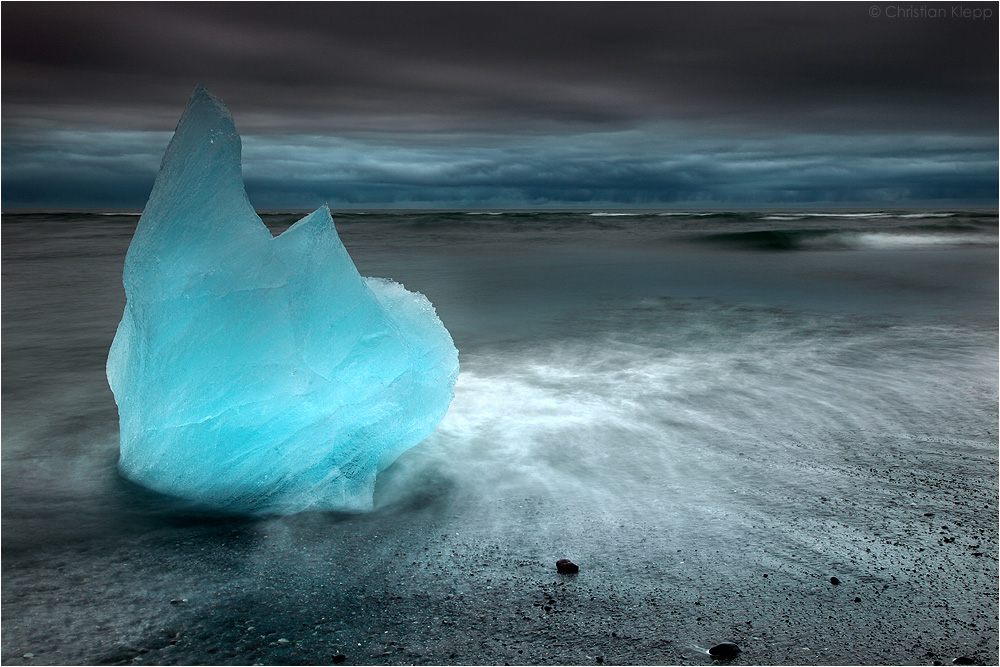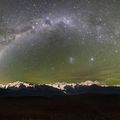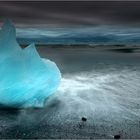Evanescence
Bei Ebbe stranden die größten Eisberge in der Brackwasserlagune Jökulsárlón am Vatnajökull am Ausfluss des Gletschersees. Der Abfluss aus der Lagune wandelt sich zum Einstrom sobald der Meeresspiegel höher als der Seespiegel liegt. Die aufgestauten Eisberge rotieren dann in großen Kreisen in der Strömung. Sobald nach der Flut das Wasser wieder abzulaufen beginnt driftet eine Armada großer Eisberge in den Ozean, wo sie der Brandung ausgesetzt werden. Nur wenige Eisberge überstehen den Brandungsschlag und stranden bei Ebbe. Dieses Schauspiel ereignet sich zweimal täglich und macht diese Eisberge einzigartig, da die Szenerie bereits nach sechs Stunden der Vergangenheit angehört. Sobald die nächste Flut beginnt, werden die Eisberge in der Brandung vollkommen zerstört. Dieser Eisberg ist 2.5 m hoch und seine türkise Farbe des dichten Eises zeugt von seinem hohen Alter. Die Schneeflocken die diesen Eisblock bildeten fielen vor 1000 Jahren auf dem Plateau des Vatnajökull Gletschers. Die rissige Struktur des Eises lässt die ungeheuren Drücke und Spannungen erahnen, denen das Eis während seiner Reise durch den Gletscher ausgesetzt war. Genau an diesen Schwachstellen wird der Eisberg in der Brandung der nächsten Flut für immer zerfallen.
Juli 2010
Canon 5D MkII, Canon L 16-35 mm, f/16, 3 Sek, 50 ASA, Stativ
Mehr Information:
www.lichtjahre.eu
Where Geoscience Meets Art
----
Due to the density of ice about 90% of the volume of floating icebergs is below the waterline. At low tide the largest icebergs ground on huge boulders that are part of the end moraine rock barrier at the outflow of the proglacial tidewater lake Jökulsárlón at Vatnajökull. The outflow current reverses when the sea level becomes higher than the lake level resulting in an inflow of water into the lagoon. This causes the accrued icebergs to float free again and they begin to rotate in large circles. As soon as the tidal water level is decreasing again the current reverses back into an outflow. A whole armada of icebergs floats into the ocean where they get attacked by the waves. Only the largest icebergs survive the wave attacks long enough to become beached at low tide. This spectacle repeats twice daily. All icebergs are unique as the scenery is absolutely evanescent because the next tide will destroy them completely. This iceberg is 2.5 m (8 ft) high and its deep blue of the dense ice indicates that the snowflakes it is composed of were falling on top of the Vatnajökull icecap about 1000 years ago. The cracked structure of the ice uncovers the immense pressure and stress the ice was exposed to while being part of the glacier. This iceberg will quickly fall apart along these fracture zones when being exposed to the surf again.
July 2010
Canon 5D MkII, Canon L 16-35 mm, f/16, 3 sec, ISO 50, tripod
More information:
www.lichtjahre.eu
Where Geoscience Meets Art





















Bea Feldmann 19/02/2021 22:39
Fantastisch und vor allem durch Deine Erklärung ausdrucksstark.Liebe Grüße Bea
Stefan Thaler - thalerst 28/04/2011 20:25
Excellent!!!laura fogazza 23/01/2011 23:32
+++laura
Monika Drobez 23/11/2010 9:17
TOP!L.G.
Monika
Marion Str. 20/11/2010 10:57
Einfach wunderschön!LG
Marion
UlliB. 20/11/2010 5:19
Ein so genial er- und durchleuchtetes Stück Eis habe ich selten gesehen.Grüße von
Ulli
Christian Schweiger 19/11/2010 22:09
Tolle Aufnahme!Gefällt mir gut.
Gruß Chris
Norbert Bramkamp 19/11/2010 19:50
+++Polarfuchs 2 19/11/2010 16:52
Wunderschön!Biggi-H 19/11/2010 16:13
Super ! Das Blau kommt einfach wunderbar rüber.lg Biggi_H
donluicu 19/11/2010 14:53
tres joli, bravouta theile photography 19/11/2010 14:34
Fantastische Fotos: eins schoener als das andere in deiner Gallerie und Homepage!!!Tolles Projekt! Einzigartige Fotos!
Gruesse Uta
Bineta 19/11/2010 14:17
Hoch interessant und eindrucksvoll!:)
Fotos by Chris Bauer 19/11/2010 13:17
die farbe ist unschlagbar ;)lg chris
wws 19/11/2010 13:02
eine excellente arbeitgruss wolfgang